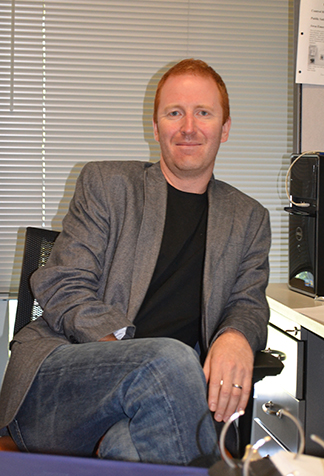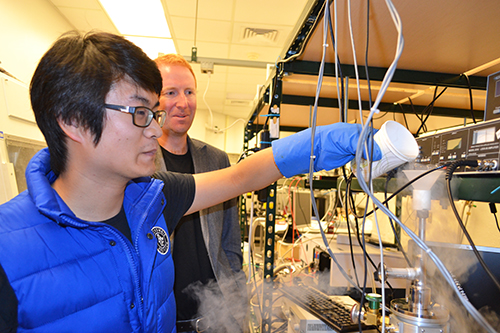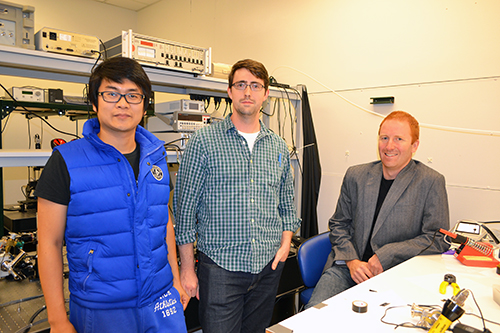ECE's Daniel Wasserman Does "Whatever It Takes to Get Students to Learn"
September 25, 2014

ECE Assistant Professor Daniel Wasserman
Assistant Professor Daniel Wasserman of Illinois' Department of Electrical and Computer Engineering (ECE) has never met a STEM education challenge he hasn't liked. While he enjoys working with Illinois engineering students (whom he says "are, of course, top, top students, and they're fantastic"), for a change of pace—and maybe a challenge—he also likes to work with non-engineering college students, high school students, even grade-schoolers.
Wasserman's research area is Mid-Infrared Photonics, or developing materials or devices that generate, detect, or interact with infrared light. (In layman's terms, it's the optics of materials that can interact with light our eyes can't see.) He and the students in his lab glibly toss around words the rest of us have heard but only vaguely understand to have something to do with computers and the internet: semiconductors (which he calls the foundation of modern communication and computing), lasers, detectors, and fiber optics (which guide light).
However, in addition to his research on optics, he likes to teach about it.
For example, he developed a course designed for undergraduates on south campus who have little experience in science and engineering. "The idea was to try to bridge the north-south campus gap to show them what scientists do." He hopes to engage future politicians, venture capitalists, business people, journalists, and more generally "People who might not be scientists but who need to interact with scientists, or who use the things that scientists generate."
"ECE 198: In a New Light: Hands-On Optics for Non-Scientists" is a hands-on course designed to teach students what it means to work in a lab, what it means to do science, and how to present that science. Though the course is about optics, which Wasserman calls "a subject that I like, and I find fascinating," he says optics is just a vehicle.
"Yes, I want them to understand optics," he explains, "but the end goal of the course is not to have them be optics ‘stars'…I want them to be able to understand how scientists operate; I'm more concerned about them understanding what it means to show something experimentally; what a scientist means when they talk about evidence, to understand and analyze results."
His main goal in the course is to encourage students to think critically. "That's one of the most important things I try to drill home," says Wasserman. "Don't just accept everything; think about whether something makes sense or not. Then prove it!"
While the course was designed for non-engineering students, it's also a Discovery Course for freshmen Engineering students. In fact, one undergrad liked the course so much that she joined Wasserman's lab and is considering switching from Computer Science to Electrical Engineering.

Daniel Wasserman looks on as grad student Lan Yu pours liquid nitrogen into a device in his lab.
Since Wasserman clearly enjoys working with a wide range of students from grad students seeking their PhDs, to engineering undergrads destined for real-world jobs in a couple of years, all the way down to fourth graders who probably don't even know what engineering is, what is his Philosophy of Education?
He claims he got asked that at a job interview once, and replied, "Whatever it takes to get the students to learn." Although the person interviewing him indicated that wasn't a philosophy, and although he asserts, "The fact is that I don't have a teaching philosophy," Wasserman then goes on to explain this philosophy in detail, and back it up from personal experience.
"Every student is different," he acknowledges, then defines different approaches he has used with different genres of students. First, he shares an anecdote about his early experimentation with teaching methodology when he first began teaching at Princeton, then at U-Mass-Lowell.
"I always gave a really, really hard first exam. When you give a really, really hard exam at Princeton, students freak out, and they start working non-stop. And they just put so much effort into that class because you scare the hell out of them. And you get these amazing results because the kids are just working their tails off."
Since this method was so successful at Princeton, he tried it his first semester at UMASS, but with completely different results: "I lost the class," he admits. "I mean, they were still there, but they had all given up. These were just very different students. They didn't have the confidence in themselves; they didn't have the background."
(In their defense, Wasserman clarifies that many of those students had been dealing with extenuating life issues: soldiers returning from Iraq with PTSD, families who had been laid off in the recession; students who had to take their kids to school when day care fell through—further corroborating his premise that every student is different.)
So did Wasserman try the really-really-hard-first-exam thing when he got to Illinois? Older and wiser, he says no: "One learns to temper some of these excesses. It worked at Princeton, but was it the best thing to get the kids incredibly excited about the subject? Scaring students is not always the best thing to do."
Regarding the idea of a universal teaching philosophy, Wasserman says there's no one philosophy that can apply to students across the board; all students are different, and require different approaches: "The idea that you could take a single teaching philosophy and apply that to students at Princeton; apply that to students at UMass-Lowell; apply that to students at Illinois—it's laughable; it's ridiculous."
And while Wasserman insists he doesn't have a teaching philosophy, the fact is that he has many—tailor-made for different genres or levels of students.
For example, he explains that the approach he takes in a core course in ECE is very different from the approach he would take for an outreach activity or something with high school students, or non-science undergrads.
So, what is his philosophy for engineering students? Even within a given classroom, he might have to take several different approaches. "It totally depends on what kind of student you're dealing with within a given class; the way you interact with students," he explains.
For example, when teaching engineering students a core course, with some, he adopts a rather Mary-Poppins-esque, Spoonful-of-Sugar-Makes-the-Medicine-Go-Down stance:
"For a lot of the students, this is a course that is a requirement," admits Wasserman. "They come in with the attitude that, 'Ok, this is my medicine; I gotta' take it.' So those students, you want to show them how exciting it is; but you have to be realistic; a large portion of those students, they're going to view it as medicine. So my job is to make it that bubble-gum-flavored medicine that at least they can sort of gag down."
Then there are the students who clearly want to be there, who are excited about learning. "Those students who come to me with probing questions, with enthusiasm for the subject, those are the ones I am more than happy to lavish extra time and attention on...Those are the ones you want to inspire; you want to answer their questions; you want to be available; you want to show them extra stuff and reach out to them; get them into the lab, for instance."
Thus he's developed a number of hands-on activities related to optics to make learning exciting. For example, in one activity, students build a wireless messaging system; using two computers, they send light across the lab, and the two computers talk to each other optically.
Wasserman says he designed some of these lab activities to be modular so they can be condensed into smaller time-frames and done with high school students, who like activities and competitions.
And his goal in outreach is to make it fun: "I try to get students excited about science, and to understand why science can be so exciting and so much fun; and maybe even have them learn, but not actually realize that they're learning anything."

Left to right: Wasserman Group grad students Lan Yu, Will Streyer, and Assistant Professor Daniel Wasserman
And part of making it fun is using hands-on activities. For example, last year he worked with students in the Principal Scholar program; he gave them posterboard, paper cups, silly putty, tape, straws, and, supplying pinto beans for data, had them make their own hard drive. In addition to a hardware component, the activity had a software component; students had to come up with a code, a language. And since engineers also have to consider whether a design is cost-effective, the students had to do it cheaply; the team that earned the most money won.
In another activity, students use LED modules to send info across the room using light; they must figure out the language, how much stuff they need to buy, then send a sentence across the room.
For many activities, such as one he's done where fourth graders try to float a brass block, he's learned that introducing an element of competition—and entrepreurialism—adds to the excitement.
"That's where I got the idea of coming up with teams and businesses, because I found that when I had the students form teams, and when I paid them monopoly money, all of a sudden it just worked. (Capitalism works for a reason!) They really got excited to win that monopoly money."
Regarding teaching non-engineering students, such as in his ECE 198 course, he says, "Teaching non-scientists is very different from teaching scientists. It's a different approach."
He continues: "I still do think that it's really, really important that non-scientists have some experience in working with science and working with scientists." Therefore he's still hoping to try to get students from south campus to take an engineering class, "Albeit, an engineering class designed for students from south campus, to see how much fun it can be, that you don't have to be mathematically rigorous. There's a lot they can learn just by doing things in the lab, without any calculus, without any difficult math, and to get them to understand."
Wasserman even enjoys teaching teachers; he gave a talk this past summer to Nano@Illinois RET (Research Experience for Teachers) participants, showing them some activities he does with students.
Another genre of students, in whom Wasserman invests a great deal of himself, are the ones who work in his lab. He shares his hopes and dreams for them—parts of which are possibly tongue in cheek—or not.
Regarding the undergrads, he says, "Obviously, I want them all to grow up and become famous scientists; I want to send them to the best Ph.D. programs." What happens if his students don't go on to become famous scientists? What then? "I want them to go out and get really, really rich and donate a lot of money to the University of Illinois."
Story and photos by Elizabeth Innes, Communications Specialist, I-STEM Education Initiative
More: ECE, Faculty Feature, Undergrad Education Reform, 2014













.jpg)
















